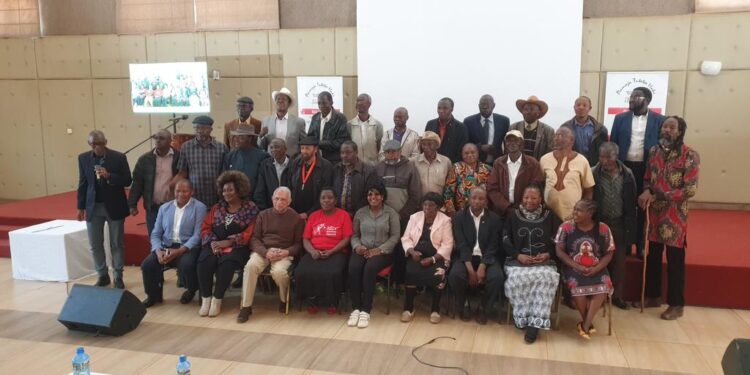Kenya featured frequently in international news in the 1990s because of the fight for freedom and democracy under the dictatorial regime of the ruling independence political party, Kanu. However, the images from Kenya that were flashing around the world following the events of March 3, 1992 were particularly harrowing. There were numerous photos and tapes of armed policemen assaulting naked, mostly elderly, women. Their crime? They had been camping at the iconic Uhuru Park to demand the release of political prisoners, and the police were determined to dislodge them.
The women – mothers, sisters, other relatives, and sympathisers of political prisoners – had on February 28 gathered at what later came to be known as Freedom Corner in the park to demand the release of 52 people detained because of their political views. Their hunger strike and protest attracted the attention of the media, which reported the happenings regularly. This displeased the Kanu regime, which sent security officers to chase the women out of the park. The officers used batons, fired gunshots into the air, and hurled tear gas at the protesters.
Led by Nobel laureate Wangari Maathai, the women had presented a petition to then Attorney General Amos Wako, asking for the release of the prisoners to no avail.
After being routed by police, most of the women took refuge at the nearby All Saints Cathedral, where they continued their protest.
On July 28, 2022, representatives of the Release Political Prisoners lobby group and other freedom fighters gathered in Nairobi to commemorate 30 years of the heroic actions of those women.
The occasion was particularly poignant as the country prepares to hold the seventh general election under the umbrella of freedom and multipartyism, which Kenyans fought so fiercely to attain 30 years ago.
The celebration, held at the All African Conference of Churches – Desmond Tutu Conference Centre, marked a major milestone in the history of Kenya and served as a wake-up call to continue fighting against state-sponsored injustices.
Some of the 52 political prisoners, who were present during the celebration, narrated their ordeals, describing how they were captured and tortured. Some were held incommunicado for months. They shared their sentiments about their struggle in prison and expressed gratitude for the sacrifice of their mothers and other women to ensure their freedom. They urged Kenyans not to forget history.
“As we celebrate these mothers, let us contextualise our history, let us write our history correctly, let us for once as Kenyans put our history right,” Wahu Kaara, a Global Social Justice activist, said.
She urged young people to take over the battle and “…play your historical role to locate the patriotic history and finalise the race by giving ourselves the state that is Kenya.”
Speaking during the ceremony, Bishop Emeritus Peter Njenga, the longest-serving provost in the Anglican Church and who was in charge of All Saints Cathedral at the time, described how 18 of the women came in that day and how he hid them in a bunker.
“Little did I know that they were going to stay there for 11 months,” Njenga said.
Having no money of his own, he pleaded with friends to help the women. Many people chipped in with donations of food, blankets, and anything they could get as the cathedral became a daily meeting point for the protesters.
Bishop Njenga’s decision to help the women made him a target of attacks. His fellow church leaders did not support his actions and President Daniel arap Moi’s regime threatened him.
Throughout the 1980s and early 1990s, Kenya’s political atmosphere was characterised by brutal repression under the single-party rule of President Moi. Any form of political dissension was swiftly met with interrogation, detention, and torture. Many students, journalists, lawyers, and human rights advocates were among those imprisoned for perceived anti-government statements, ideas, and actions.
Representatives from the RPP narrated how sympathetic Kenyans joined them with donations of food, blankets, and tents as they prayed and sang freedom songs while setting up their banners and issuing flyers to curious Kenyans as they continued their vigil at the park.
“I was arrested together with my brother, Joseph Mwaura Kinuthia, my sister, Margaret Wangui Kinuthia (who passed away on Christmas day four years ago), and my brother’s wife, Mary Mwaura. The four of us were charged in court together with Koigi Wa Wamwere and Mirugi Kariuki (now deceased). There were eight of us. We were locked up at Nyayo House and later at Kamiti Prison for two-and-a-half years between 1990 and 1993. Koigi, Mirugi, and I were the last of that lot to be released – in early 1993,” said advocate Rumba Kinuthia.
He echoed the sentiments of other activists that the war has yet to be won.
“We are still in the struggle and we urge everyone to watch out, particularly at this time. Let nobody tell us to forget history,” Kinuthia said.
The brutal police action of March 3, 1992 so enraged the women that some of them stripped naked, shook their breasts at the officers, and shouted, “What kind of government is this that beats women! Kill us! Kill us now! We shall die with our children!”
Some of the policemen turned away and left the scene. According to Prof Maathai, the action of disrobing was particularly effective in stopping the police because, “In the African tradition, people must respect women who are close to their mother’s age, and they must treat them as their mothers. If men beat mothers, it is like sons violating their mothers, and the mothers respond by cursing them. And they curse them by showing them their nakedness.”
The violent attack made newspaper headlines and sparked violence all over Nairobi. The next day the women regrouped at All Saints Cathedral because the government had sealed off Uhuru Park.
Over the next 11 months, the women continued their campaign. They held open forums and spoke about democratic procedures and citizen rights, asserting that individuals should not be jailed because of their political beliefs.
Thousands of supporters visited the mothers, and many political opposition groups and women’s organisations openly lent their support.
On March 31, the mothers attempted to deliver a petition to President Moi, but the police turned them away and on the evening of April 1, police officers raided All Saints Cathedral and occupied the grounds for three days as the women barricaded themselves in the church bunker.
On April 12 the Archbishop of the Anglican Church, Manasses Kuria, declared that “idlers” were officially barred from the cathedral grounds, and that the church was “…a sanctuary for the mothers of the political prisoners”.
On April 16 and 17, the protesters distributed 6,000 leaflets with information about their sons and how they had been arrested.
The campaign continued until after the release of the last three political prisoners – Koigi Wamwere, Rumba Kinuthia, and Mirugi Kariuki – on January 19, 1993.
The commemoration of July 28, 2022 celebrated several mothers, including Marianne Nyabola, Monica Wangu Wamwere, Ruth Wangari Thungu, Milka Wanjiru Kinuthia, Margaret Wangui Kinuthia, Gladys Thiitu Kariuki, Veronica Wambui Nduthu, Leah Wanjiru Mungai, Elizabeth Wanjiru Matenjwa, the late Marcell Ojuka, Margaret Opiata, Joyce Wafula, Octavia Muthoni Mutai, Rael Kitur, Rose Barasa, Phoebe Ong’wen, and Beldina Ojwang Adhiambo,
The women’s protest was one of the many actions taking place at the time that helped to end the period of political imprisonment in Kenya and added to the momentum of reforms that had started in the early 1990s, leading to momentous constitutional changes that included the repeal of Section 2A in December 1991, which ushered in multiparty democracy and led to modern-day Kenyan laws such as presidential term limits.







